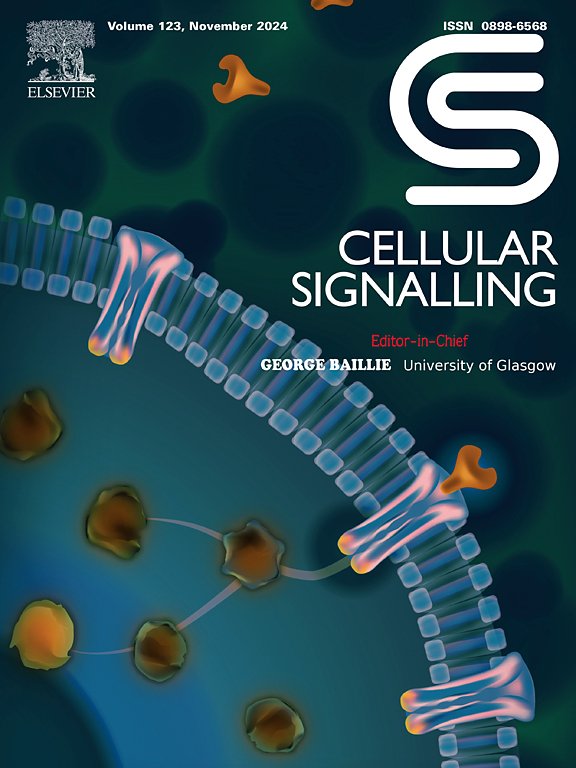Roflumilast inhibits neuronal ferroptosis via AMPK/Nrf2/HO-1 signaling and promotes motor function recovery after spinal cord injury in rats
IF 3.7
2区 生物学
Q2 CELL BIOLOGY
引用次数: 0
Abstract
Spinal cord injury (SCI) is a serious central nervous system disease. Ferroptosis is one of the major causes of spinal cord neurological loss, and targeting ferroptosis is a promising therapeutic strategy. Roflumilast has shown promising applications in the treatment of neurological diseases due to its potent anti-inflammatory and anti-oxidative stress effects. This study aimed to investigate whether roflumilast could inhibit neuronal ferroptosis to improve motor function after SCI in rats. In vitro experiments, we found that roflumilast significantly increased cell survival in an in vitro ferroptosis model, improved mitochondrial function, reduced intracellular iron, reactive oxygen species (ROS), and lipid peroxides accumulation as well as the expression of the pro-ferroptosis proteins, long-chain acyl-coenzyme A synthase 4 (ACSL4), and prostaglandin-endoperoxide synthase 2 (PTGS2), and increased the expression of ferroptosis-inhibitory protein glutathione peroxidase 4 (GPX4), and ferritin heavy chain 1 (FTH1) expression. Mechanistically, these protective effects were achieved by activating AMP-dependent protein kinase (AMPK)/nuclear factor E2-related factor 2 (Nrf2)/heme oxygenase-1 (HO-1) signaling and were attenuated when AMPK signaling was blocked. In vivo experiments, roflumilast attenuated spinal cord tissue damage, increased the number of motor neuron survivors, and improved motor function after SCI in rats. Overall, activation of AMPK/Nrf2/HO-1 signaling by roflumilast attenuated neuronal ferroptosis and improved motor function after SCI in rats.

罗氟司特通过AMPK/Nrf2/HO-1信号抑制大鼠脊髓损伤后神经元铁下垂,促进运动功能恢复
脊髓损伤是一种严重的中枢神经系统疾病。铁下垂是脊髓神经功能丧失的主要原因之一,针对铁下垂是一种很有前途的治疗策略。罗氟司特因其有效的抗炎和抗氧化应激作用而在神经系统疾病的治疗中显示出有前景的应用。本研究旨在探讨罗氟司特是否能抑制大鼠脊髓损伤后神经元的铁下垂,改善大鼠的运动功能。在体外实验中,我们发现罗氟米斯特显著提高了体外铁下垂模型的细胞存活率,改善了线粒体功能,降低了细胞内铁、活性氧(ROS)和脂质过氧化物积累,以及前铁下垂蛋白、长链酰基辅酶A合成酶4 (ACSL4)和前列腺素内过氧化物合成酶2 (PTGS2)的表达,增加了铁下垂抑制蛋白谷胱甘肽过氧化物酶4 (GPX4)的表达。铁蛋白重链1 (FTH1)表达。从机制上说,这些保护作用是通过激活amp依赖性蛋白激酶(AMPK)/核因子e2相关因子2 (Nrf2)/血红素氧合酶-1 (HO-1)信号来实现的,当AMPK信号被阻断时,这些保护作用就会减弱。在体内实验中,罗氟司特能减轻大鼠脊髓组织损伤,增加运动神经元存活数量,改善脊髓损伤后的运动功能。总的来说,罗氟司特激活AMPK/Nrf2/HO-1信号可以减轻大鼠脊髓损伤后的神经元下垂,改善运动功能。
本文章由计算机程序翻译,如有差异,请以英文原文为准。
求助全文
约1分钟内获得全文
求助全文
来源期刊

Cellular signalling
生物-细胞生物学
CiteScore
8.40
自引率
0.00%
发文量
250
审稿时长
27 days
期刊介绍:
Cellular Signalling publishes original research describing fundamental and clinical findings on the mechanisms, actions and structural components of cellular signalling systems in vitro and in vivo.
Cellular Signalling aims at full length research papers defining signalling systems ranging from microorganisms to cells, tissues and higher organisms.
 求助内容:
求助内容: 应助结果提醒方式:
应助结果提醒方式:


